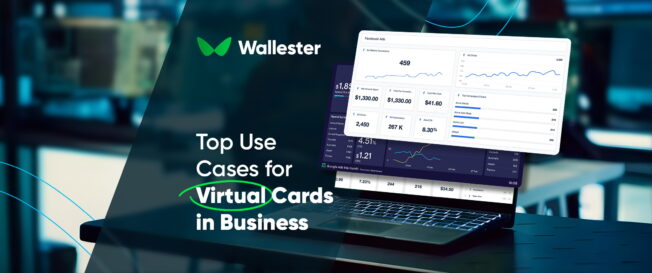Traditional business payment methods come with built-in friction – from chasing receipts to managing delays and preventing misuse. They slow down operations and make it harder to stay in control, especially as companies grow. Virtual cards offer a modern alternative that’s gaining real traction. They let businesses issue secure payment details instantly, control spending in real time, and reduce the risks tied to shared cards or outdated processes. This article looks at how virtual cards work and where they bring the most value.
Use Cases for Virtual Cards in Business: Summary
Digital cards transform how businesses handle transactions across multiple scenarios:
- Employee spending management to control and track staff expenses with individual spending limits.
- Subscription and SaaS for managing recurring software costs using dedicated payment methods.
- Travel expense handling to simplify business travel while maintaining financial oversight.
- Marketing and media buying for controlling advertising spend across platforms and campaigns.
- Supplier and vendor transactions to streamline B2B payments with greater security.
- Departmental budget allocation for distributing spending authority across different business units.
What is a virtual card?
A virtual card is a payment method that exists only in digital form, created for online or mobile transactions. Unlike physical cards, it can’t be held or swiped – its details (card number, expiry date, CVV) are accessed through an app or web platform.
Unlike digital wallets like Apple Pay or Google Pay, which store existing card information, virtual cards generate entirely new credentials tied to your business account or credit line. This gives more control over each transaction and adds an extra layer of security.
Multiple cards can be issued in seconds, each with its own limits, rules, and lifespan – making them especially useful for managing company expenses across teams, vendors, and projects.
Want a broader overview? See The Complete Guide to Virtual Cards for Business for a detailed breakdown of how they work, key features, and implementation tips.
How does a virtual card work?
The technology works through tokenisation – replacing sensitive data with unique digital tokens for each transaction. When you request one, the system creates a new number, expiry date, and CVV code that connects to your primary account.
Two main models handle usage:
Single-use options create unique credentials for one transaction only. Once you’ve used them, the details become worthless, stopping any unauthorised future use. This works brilliantly for one-off supplier transactions or risky online purchases.
Multi-use versions work like regular cards but stay digital. These can handle multiple transactions within set limits, making them perfect for ongoing supplier relationships or recurring expenses.
Creating virtual cards usually takes seconds through web platforms or API integration. Companies can generate them on-demand, set spending caps, choose merchant categories, and pick expiry dates before sharing details with team members.
Reducing fraud with virtual cards
Digital cards slash fraud exposure through multiple security layers that regular methods can’t provide. Dynamic CVV codes change regularly, making stolen information useless after short periods. This rotating security feature helps companies make frequent online purchases.
Controlled spend caps act as automatic fraud prevention. Unlike company credit cards with high limits, these can be set with precise spending amounts – from £50 for small purchases to thousands for major supplier transactions. If fraudsters grab details, their potential damage stays limited to the preset amount.
Single-use cards provide ultimate fraud protection for risky transactions. Cross-border dealings, new supplier relationships, and online marketplaces become safer when using instruments that self-destruct after one use. This approach cuts ongoing fraud risk while keeping convenience.
Real-time transaction monitoring catches fraud immediately. Unlike traditional expense reporting that spots issues weeks later, platforms flag suspicious activity within minutes, letting you respond quickly to potential security breaches.
Security boosted by virtual cards
Virtual cards offer stronger protections than traditional payment methods, reducing risk and improving visibility across every transaction.
- Merchant-specific cards restrict usage to approved vendors. For example, a card created for software tools won’t work at unrelated merchants, helping prevent misuse.
- Real-time tracking allows finance teams to monitor payments as they happen and respond quickly to suspicious activity.
- Automated audit trails record each transaction with full details, including merchant name, amount, date, and time, simplifying reconciliation and improving transparency.
- Issuing individual cards instead of sharing company ones improves accountability and reduces the chance of errors or fraud.
- Businesses can define time limits, usage categories, and geographic regions for each card, with options to deactivate them automatically when no longer needed.
This level of control helps businesses strengthen security and simplify how payments are made and monitored.
Virtual Card Types
Understanding different types helps businesses select appropriate solutions for specific use cases. Each type serves distinct operational requirements and offers varying levels of control and functionality.
Single-use cards excel in high-security scenarios where one-time transactions are required. These work well for:
- New supplier dealings where trust hasn’t been established
- Large one-off purchases requiring additional security
- Online marketplace transactions with unknown merchants
- International dealings where fraud risk is elevated
Multi-use versions provide ongoing capability with extended validity periods. They suit:
- Recurring subscription expenses
- Regular supplier relationships
- Employee expense access for ongoing use
- Departmental spending with monthly or quarterly limits
Business prepaid cards operate using pre-loaded funds, offering strict spending control. Companies load specific amounts onto these cards, preventing overspending and eliminating credit risk. This model works best for project-based spending or temporary employee access.
Credit cards function like traditional business credit cards but exist only digitally. They access credit lines and usually offer higher spending limits for larger business purchases. They’re ideal for established businesses with good credit ratings requiring flexible options.
Debit cards link directly to business bank accounts, debiting funds immediately upon transaction completion. This real-time processing provides excellent cash flow visibility while maintaining spending control through account balance limitations.
API-issued cards integrate directly with business software systems, allowing automated creation and management. Technology companies often prefer this approach for seamless integration with existing financial workflows.
Platform-managed cards operate through web-based dashboards where users manually create and manage cards. This solution suits businesses that prefer hands-on control over automated processes.

How can virtual cards be used in business?
Virtual cards address multiple business scenarios, each offering specific advantages over traditional cards.
- Employee spending represents one of the most common applications. Rather than processing expense reports weeks after purchases, employees receive cards with predetermined spending limits for business-related expenses.
- Subscriptions and SaaS benefit significantly from virtual solutions. Each software subscription receives its own card, making it easier to track costs, manage renewals, and cancel services. When contracts end, the associated cards can be deactivated immediately, preventing unwanted charges.
- Travel expenses become more manageable with cards for specific trips or time periods. Employees receive them loaded with travel budgets, so there’s no need for personal credit use or subsequent reimbursements. Cards can be configured to work only in destination countries, adding security for international travel.
- Media buying and marketing campaigns often require separate cards for different platforms or client accounts. Virtual solutions allow marketing teams to segregate advertising spend, track campaign performance, and maintain client billing separation without managing multiple physical cards. For a deeper dive into how marketers benefit, check out Virtual Cards for Ad Spend: The Smart Marketer’s Guide.
- Supplier and vendor transactions can transition from cheques or wire transfers to digital processing, speeding up processing times while maintaining detailed transaction records. Suppliers receive faster transactions, and businesses gain better expense tracking and fraud protection.
- Departmental budgets become easier to manage when each department receives cards with monthly or quarterly spending limits. This approach distributes spending authority while maintaining oversight and preventing budget overruns.
Processing of supplier payments
Virtual cards offer a faster, simpler way to pay suppliers, especially those used frequently or for smaller purchases. Instead of waiting days for wire transfers or dealing with paper cheques, businesses can issue virtual cards in minutes. Traditional methods often involve delays and paperwork. Virtual cards speed up the process by supporting same-day payments. Suppliers receive immediate confirmation, which reduces uncertainty and helps maintain good relationships.
They are particularly helpful for routine purchases. Companies can assign cards with set limits, allowing suppliers to process payments without repeated manual approvals. When connected to accounts payable systems, virtual cards can be created automatically for approved invoices. The system generates a card with the exact amount and sends it to the supplier while logging the transaction for easy tracking.
Each payment includes full transaction details such as time, amount, and merchant, making reconciliation and audit preparation more straightforward than with wires or cheques.
The use of virtual cards across industries
Different industries use virtual cards to solve specific problems in their daily operations. These examples show how flexible and useful they can be in many types of businesses.
- Marketing and advertising agencies use virtual cards to segregate client spending across different advertising platforms. Each client receives dedicated instruments for Facebook, Google, or other advertising channels, simplifying billing and campaign tracking. When client relationships end, associated cards can be deactivated immediately.
- Logistics and transportation companies benefit from digital solutions for fuel purchases, toll expenses, and travel costs. Fleet managers can issue cards to drivers with spending limits and merchant restrictions. GPS integration can restrict usage to specific geographic areas.
- E-commerce businesses use them for dropshipping arrangements and inventory purchases from multiple suppliers. Each supplier relationship gets dedicated cards, making it easier to track costs and manage vendor relationships. Seasonal businesses can adjust spending limits based on demand patterns.
- Software and technology companies use virtual cards for managing extensive tool stacks and cloud service subscriptions. Development teams receive cards for platform credits, testing services, and development tools without requiring individual expense approvals for every purchase.
- Consulting firms issue project-specific cards that automatically expire when engagements conclude. This approach prevents consultants from accidentally charging personal expenses to client accounts while project costs are properly tracked and billed.
Benefits of virtual cards for businesses
Virtual cards offer clear day-to-day and long-term benefits that older payment methods can’t provide. Over time, these advantages help companies work more efficiently and manage money more effectively.
- Real-time control represents perhaps the most significant advantage. Businesses can modify spending limits, freeze options, or adjust merchant restrictions instantly through web platforms or mobile apps. This immediate control prevents unauthorised spending and allows rapid response to changing business needs.
- Virtual cards make it easier to see exactly how money is spent. Each transaction shows where, when, and what it was for, so finance teams no longer have to guess or wait for reports to understand spending.
- Scalability becomes effortless with digital systems. Adding new employees, departments, or projects requires seconds rather than weeks to issue new cards. Growing businesses can provision hundreds instantly without physical printing or delivery delays.
- Virtual cards offer stronger protection than traditional payment instruments. Features like changing security codes, preset limits, and merchant controls reduce the chances of misuse. If something looks suspicious, multi-use cards can be turned off right away.
- Simplified reconciliation saves time on accounting. Each transaction is automatically labelled with merchant details, so it’s easier to connect expenses to their purpose. Most data goes straight into accounting software without manual entry.
Disadvantages of virtual cards
Virtual cards aren’t perfect. They work best in digital environments and have a few limits businesses should be aware of:
- Some offline retailers, restaurants, or service providers don’t accept them, especially if they don’t support contactless or mobile payments.
- Getting started may take time. Staff need training, spending rules have to be set up, and integrations with existing systems might require tech support.
- Not all merchants process virtual cards correctly, especially in certain online stores or international markets.
- Without proper structure, things can get messy. Too many overlapping cards or unclear policies can make tracking harder instead of easier.
How to incorporate virtual credit cards into your business
Bringing virtual cards into your operations takes a bit of setup, but the payoff is worth it. Here’s a step-by-step approach to get started:
1. Choose a provider
Look for one that fits your size, systems, and spending needs. Check how it connects with your accounting tools, how fast cards can be issued, what controls are available, what support is offered, and whether the pricing and security meet your expectations. For a comparison of leading options, see Top Virtual Card Providers in 2025.
2. Define spending categories and users
Decide where virtual cards will be most useful (subscriptions, travel, suppliers) and who should have access. This helps set the right permissions and avoid misuse.
3. Set policies and controls
Create clear rules for how the cards can be used. Set limits by user type, restrict merchant categories, and decide when approvals are needed. Keep documentation simple but thorough.
4. Integrate with accounting tools
Connect your virtual card platform to tools like Xero, QuickBooks, or SAP. This cuts manual work by syncing data automatically and makes tracking easier.
5. Train your team
Walk users through the platform, explain how to request and use cards, and outline what’s expected for reporting. A quick refresher now and then helps keep everyone on track.
Why use Wallester’s virtual cards?
Wallester offers a virtual card platform suited to a range of business structures, from small teams to larger organisations. The system supports rapid issuance, allowing multiple cards to be created in minutes. This flexibility is helpful for onboarding new employees, managing one-off purchases, or allocating spend for specific projects without delay.
Cards are issued under the Visa Business network, which means they can be used worldwide at online stores and contactless points of sale. This level of acceptance supports both local and international operations without requiring separate systems.
Control features are built into the platform. Spending limits, merchant category filters, usage timeframes, and location rules can all be set for each card. These options help companies manage employee access and spending more precisely, particularly when dealing with distributed teams or project-based work. Each department can oversee its own activity, while finance teams keep full visibility through real-time reports and a unified dashboard.
For businesses with existing finance tools, Wallester supports API connections. These integrations allow card issuance and transaction data to sync directly with accounting or expense systems, streamlining workflows and cutting down on manual input.
The platform also supports European BINs and multiple currencies, which benefits companies operating across different countries. By settling payments locally and avoiding unnecessary currency exchanges, businesses can maintain clearer oversight of spending across regions.
To learn more about setting up virtual cards tailored to your business needs, visit the Wallester Business platform. The service provides instant issuance, detailed spending controls, and integration options that support efficient financial operations at scale.



